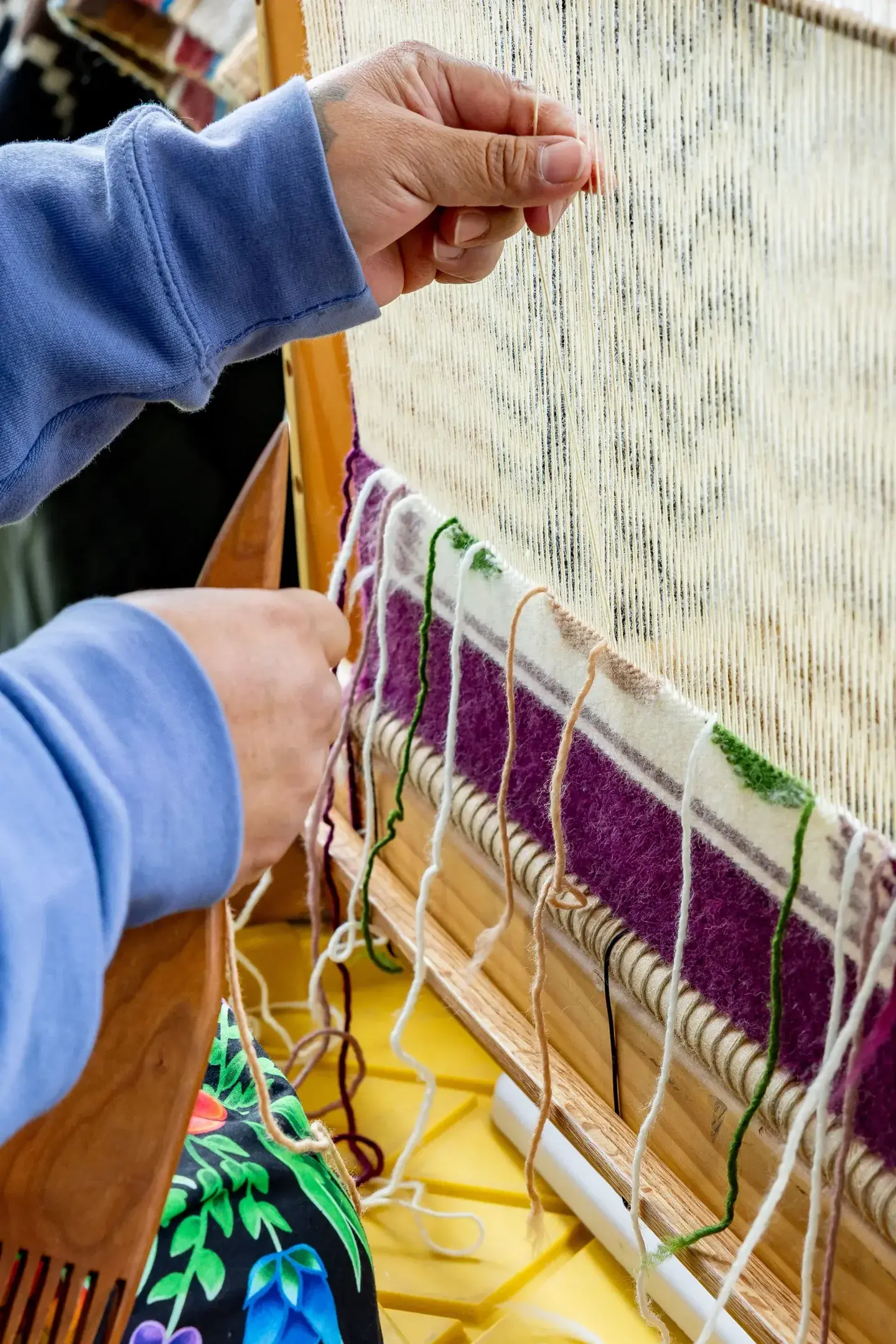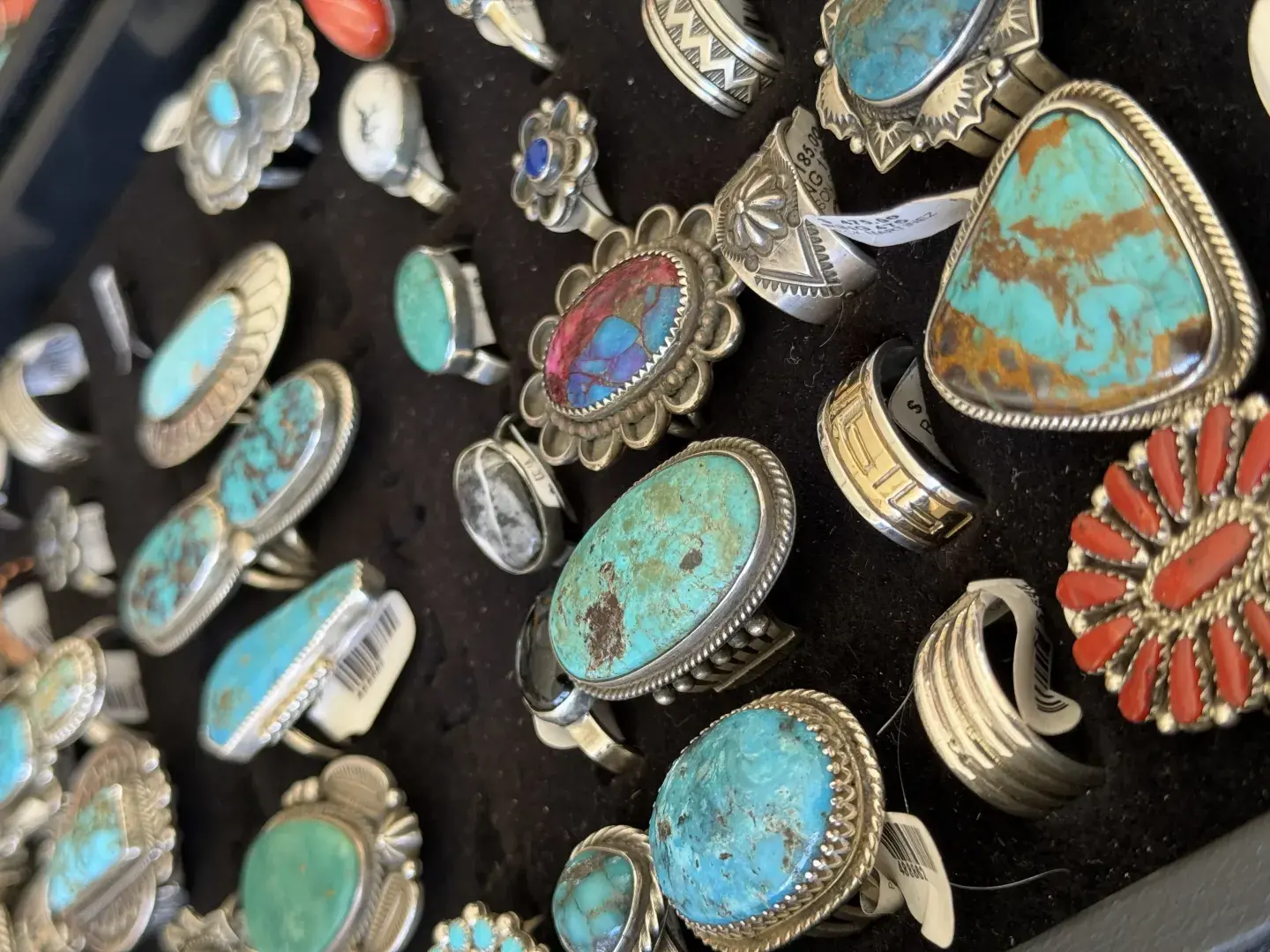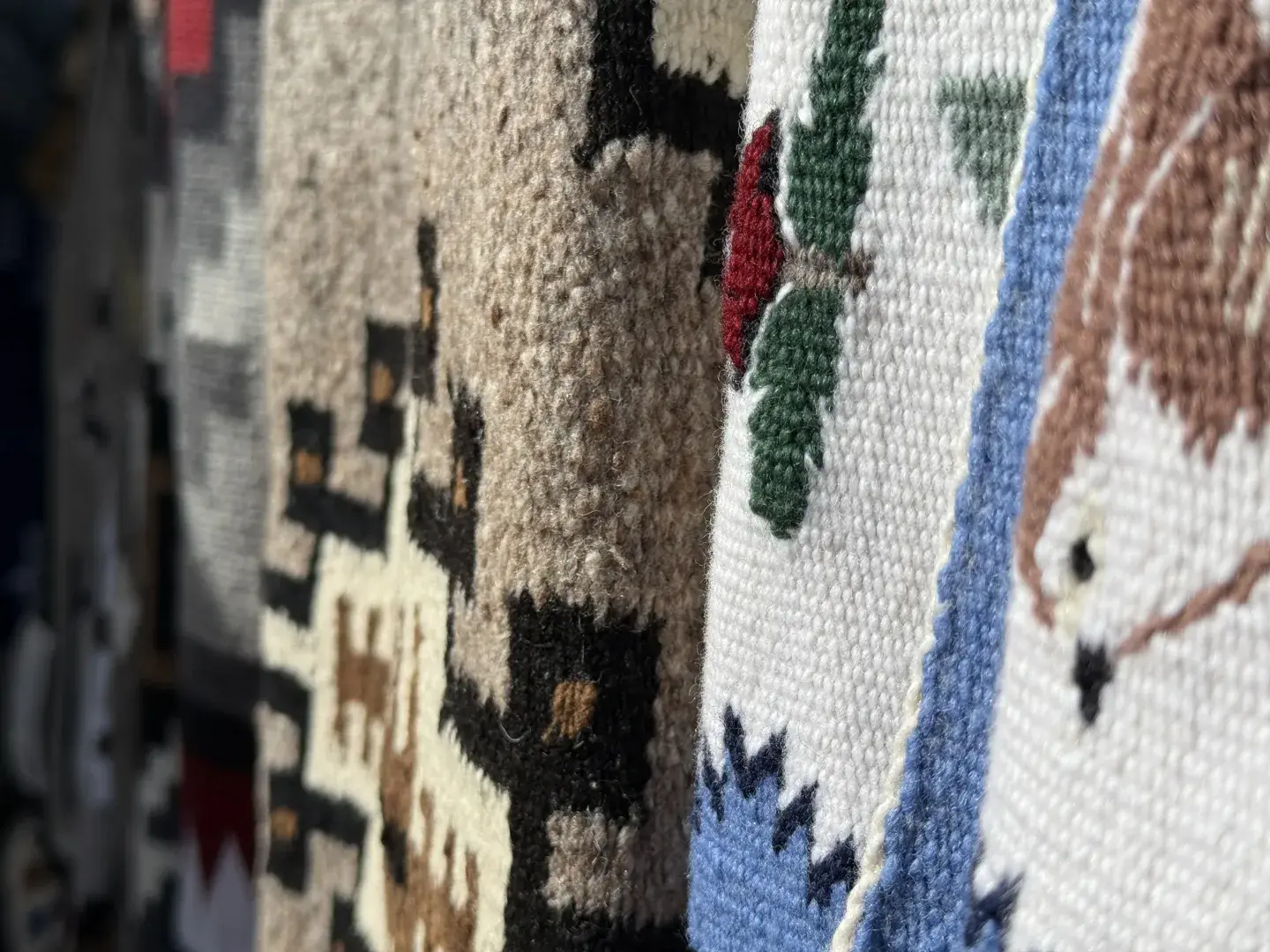
Wallace James Jr: A Legacy of Navajo Weaving at Hubbell Trading Post
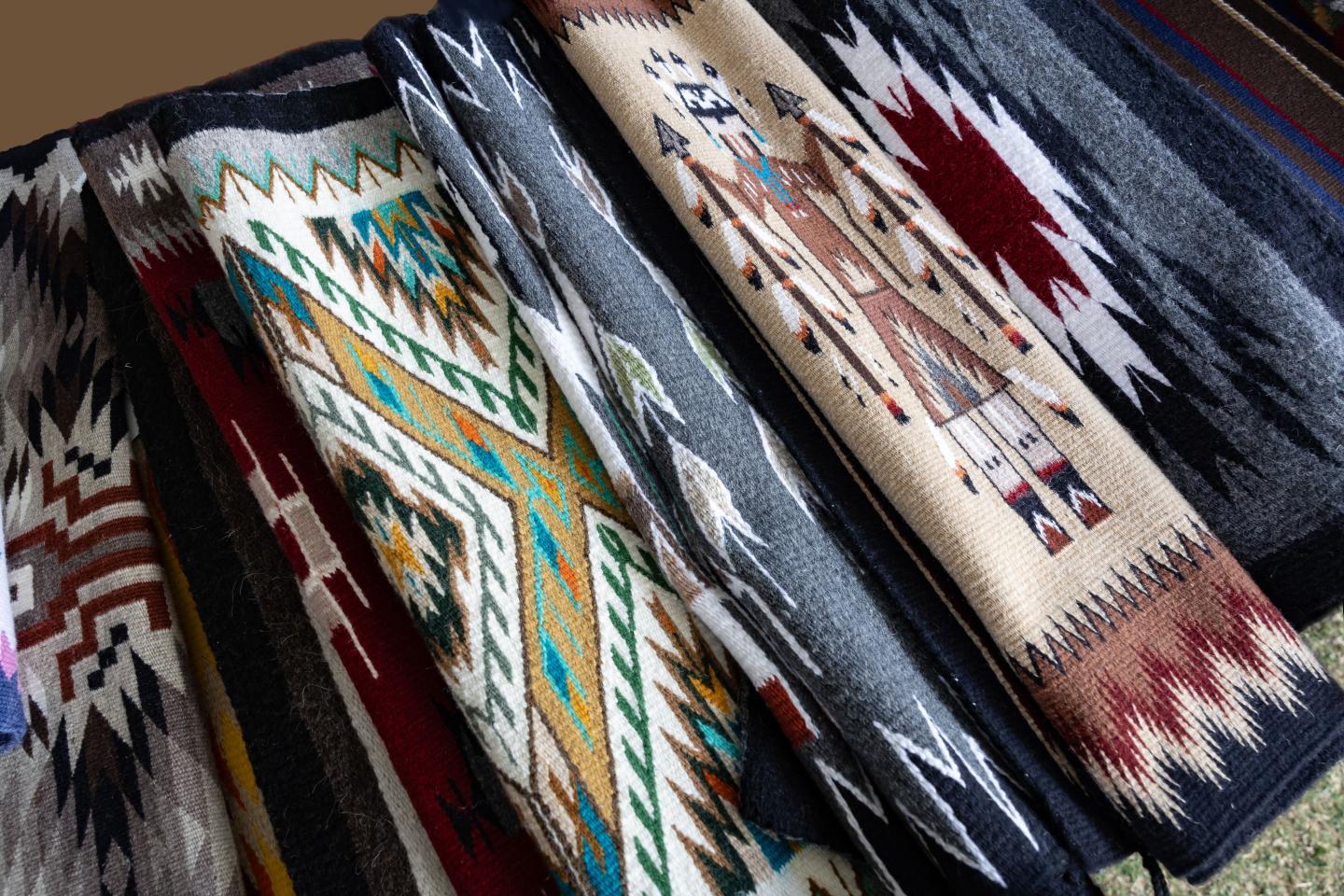
Wallace James Jr is the Trader at Hubbell Trading Post National Historic Site, the oldest continuously operated trading post in the West. He and the Hubbell team travel to sites throughout the Southwest like Bandelier National Monument, White Sands National Park, Lake Mead National Recreation Area, and Petroglyph National Monument in a traveling series known fondly as “Hubbell on the Road,” where attendees can browse exquisite Navajo rugs and jewelry and listen to inspiring talks about the history of Navajo weaving, artistry, and culture.
We had a chance to interview Wallace. Read on to learn more about Wallace’s deep connections to Hubbell’s and his Navajo heritage, and get a sneak preview of the amazing experiences waiting for you at a “Hubbell on the Road” show.
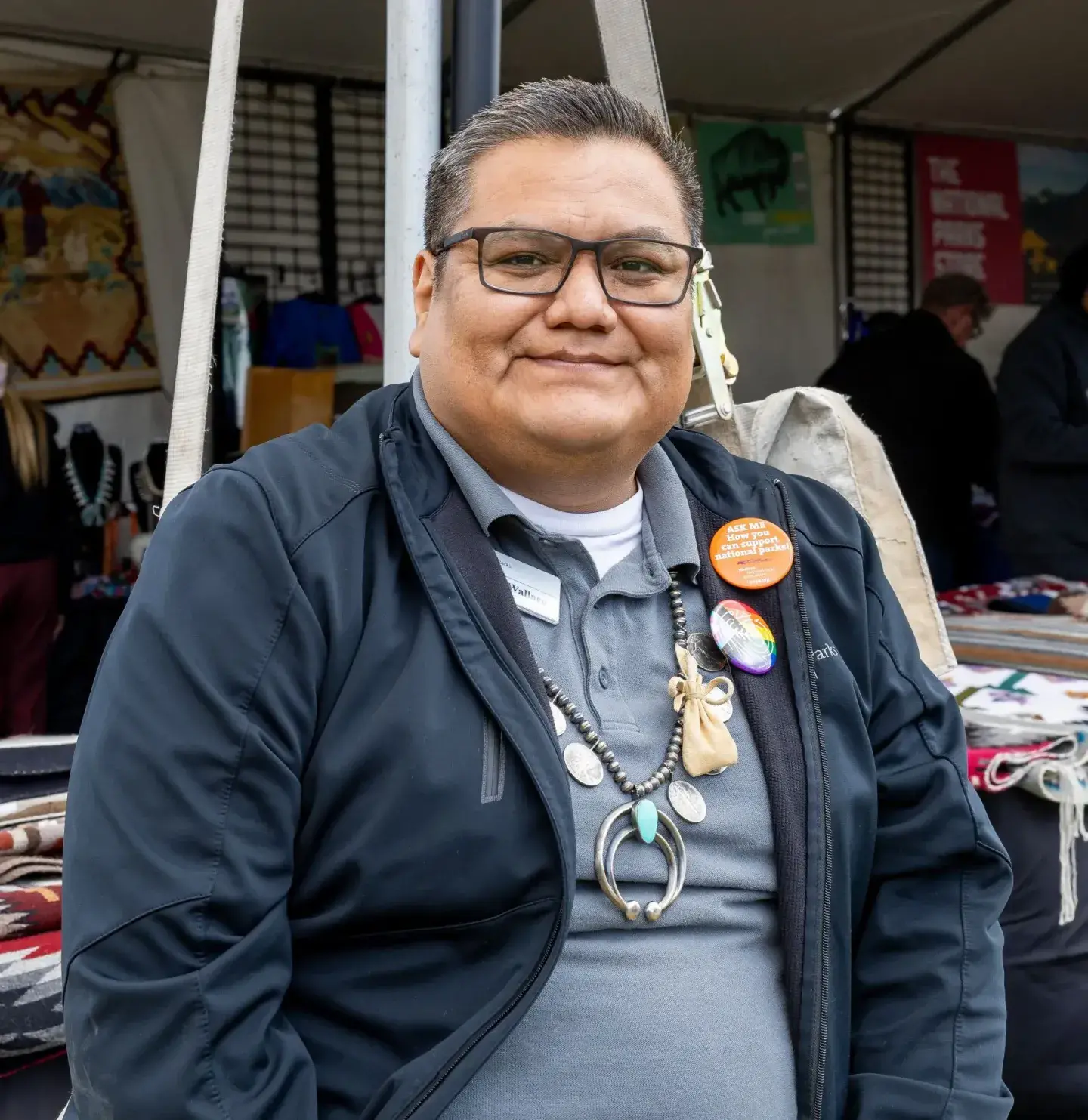
Sharing the legacy of Navajo Weaving throughout the West
Nestled in the heart of the Navajo Nation, Hubbell Trading Post National Historic Site has long been a center of cultural exchange, storytelling, and craftsmanship. For Wallace James Jr, this place is more than a historical landmark—it is home. As a Navajo trader at the post, Wallace carries forward the legacy of his ancestors, who have been connected to Hubbell’s, as it is lovingly called, for generations.
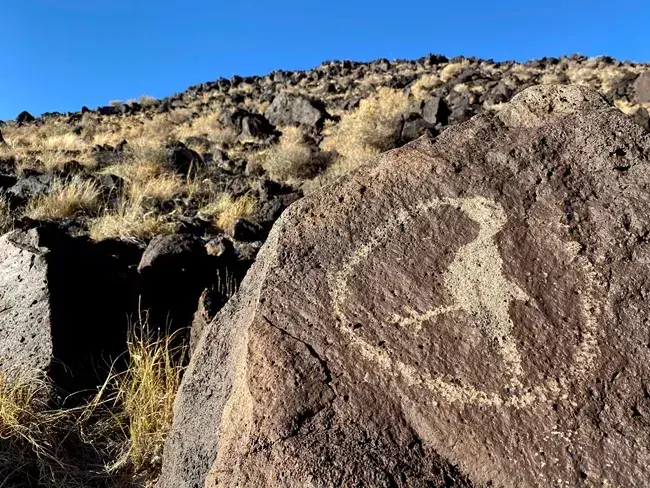
Sustaining and sharing the culture
Wallace and the team at Hubbell’s also share this legacy with broader audiences through a traveling series known as “Hubbell on the Road.” At locations like White Sands National Park, Lake Mead National Recreation Area, Petroglyph National Monument, and even at the annual Tucson Festival of Books, event attendees can browse exquisite jewelry and rugs and listen to Wallace’s special talks, each one as unique as the rugs themselves. Through his talks, he shares the history, techniques, and significance of Navajo weaving, ensuring that this sacred art form continues to thrive.
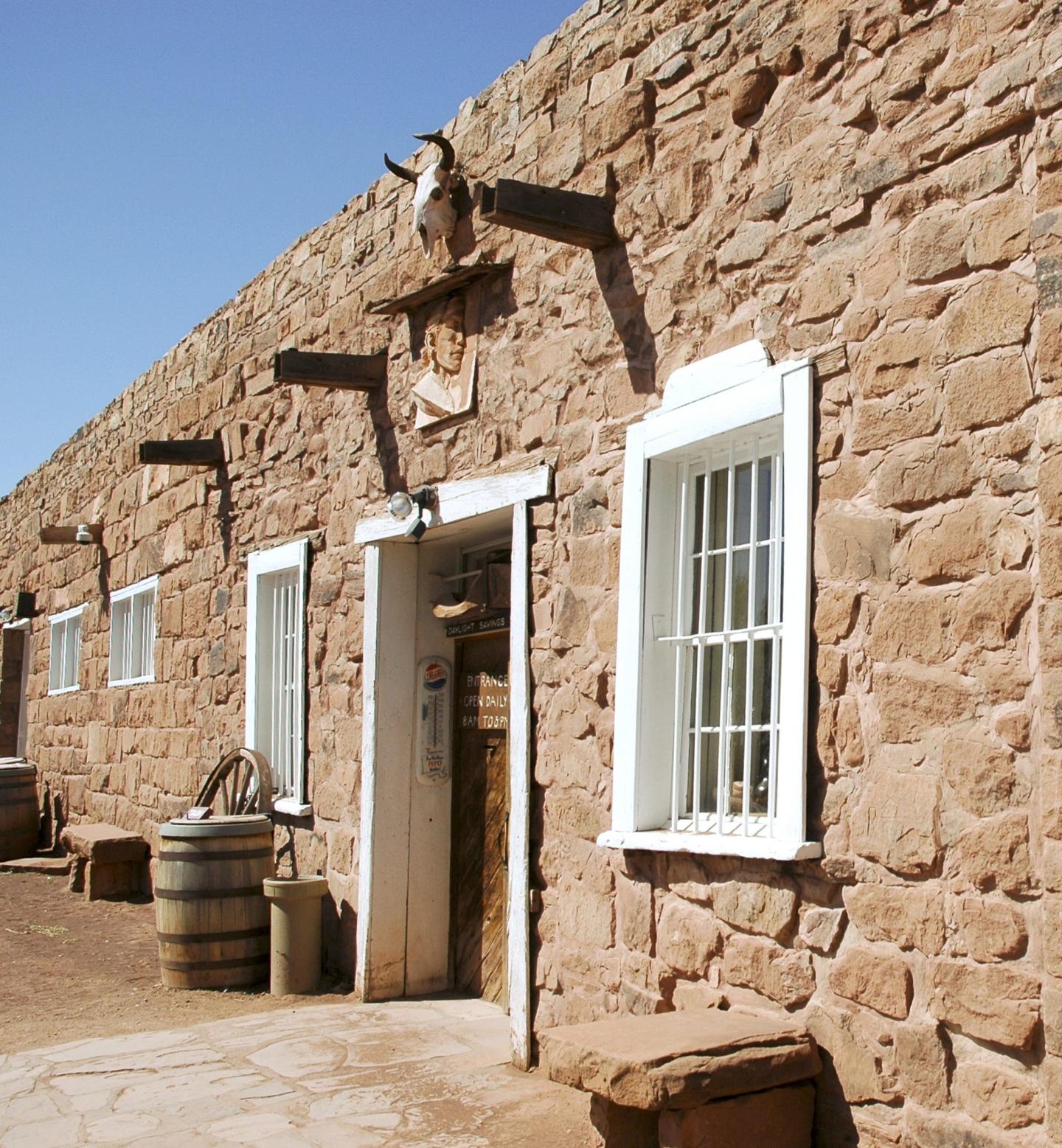
Generations of stories
“My knowledge of Navajo weaving was passed down from generation to generation,” Wallace shares. “Not just the techniques, but also the history of my family at Hubbell’s.” His mother, Janice James-Kee, was a dedicated weaver, and his grandfather, Able Kinlicheenie, worked in maintenance at the trading post. His great-grandfather, Friday Kinlicheenie (Tse Daghaa), lived and worked at Hubbell’s, and it was he who built the hogan where Wallace’s mother was born, on Hubbell’s grounds just south of the trading post itself.
Wallace’s connection to Hubbell’s is not just familial—it is deeply rooted in his very being. He spent his childhood running through the trading post, watching his mother weave, and absorbing the intricate knowledge of wool, dye, and design that he now shares with visitors. “I was raised here. My mother was born here. And our history at Hubbell’s goes all the way back to Navajo Chief Ganado Mucho.”
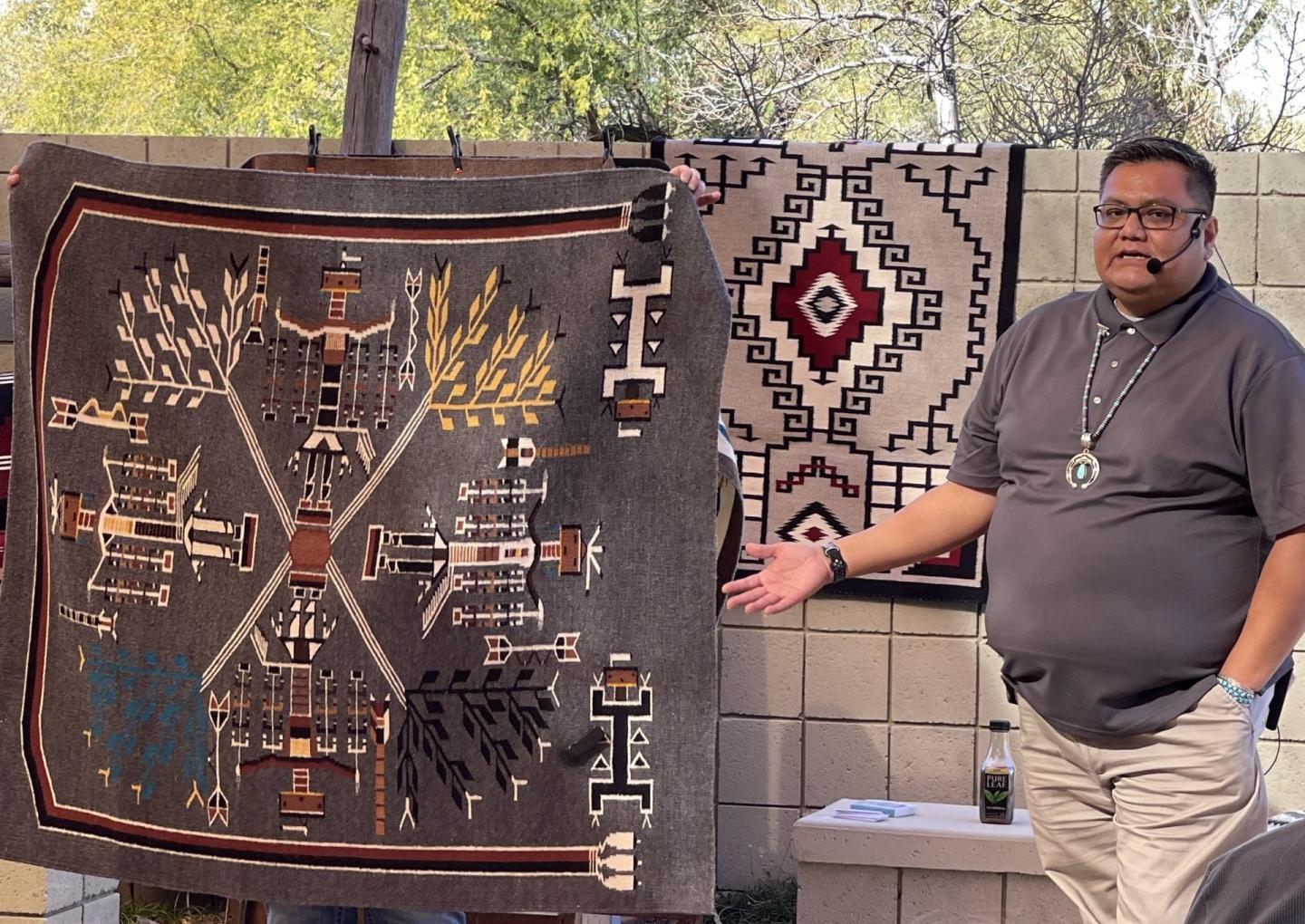
A lifelong bond with Hubbell Trading Post
Wallace’s deep connection to Hubbell’s is rooted in his family’s history, stretching back to his great-great-great-grandfather, Chief Ganado Mucho (Totohnii Hastiin), a prominent Navajo leader. His great-great-grandfather, Chief Many Horses (Bilii Lani), continued this lineage, which later included his great-grandfather, Friday Kinlicheenie (Tse Daghaa), who worked at Hubbell’s as well. Friday built the hogan near the trading post after working there for years. “He had a Navajo name, but the trader at the time couldn’t pronounce it, so they called him Friday. That name stuck,” Wallace shares, chuckling a bit.
His grandfather, Able Kinlicheenie, continued the family tradition, working maintenance at the trading post while Wallace’s grandmother wove rugs. His mother, Janice James-Kee, was born in the hogan her great-grandfather built and spent much of her life weaving at Hubbell’s. Wallace recalls childhood days spent watching his mother work. “I’d get off the school bus and meet my mom here at the trading post. I remember running around, climbing the walls.”
Even though Wallace was encouraged to pursue an education and a career outside of weaving, the art always called him back. “I never thought I’d see myself back at Hubbell’s, but here I am. It’s in my blood.” Today, he shares his knowledge daily at the post, and also through demonstrations and presentations at other sites across the West, bringing Navajo weaving to new audiences while honoring the generations before him.
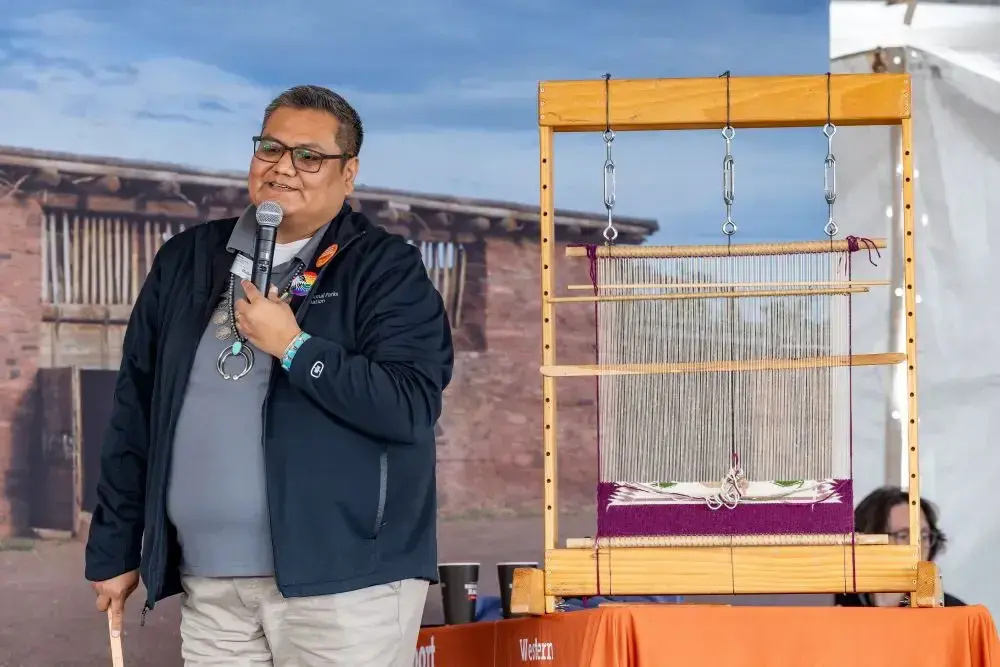
The art of Navajo weaving from sheep to rug
Today, as the Trader at Hubbell’s, Wallace ensures the highest quality rugs are brought into Hubbell’s as he nurtures relationships with Master Weavers from across the Navajo Nation. “I make sure each item is handmade and of raw materials.”
Weaving techniques vary, and Wallace highlights the influence of different regions of the Navajo Nation on design styles. Some areas are known for bold geometric patterns, while others feature intricate pictorial elements. He also delves into the significance of ply, explaining that wool can be spun multiple times to create different textures and thicknesses. The finer the spin, the tighter and more detailed the weave.
Designs rooted in tradition
Navajo rugs are more than artistic expressions—they tell stories and hold cultural significance. Every rug tells a story, and Wallace is here to share them. “When people buy a rug, they’re not just taking home something beautiful. They’re carrying the prayers, the traditions, and the blessings of the weaver with them. That’s what makes our art so special.”
Wallace integrates the storytelling and significance of basket designs, silverwork, and jewelry into his talks on the road at sites like Bandelier National Monument, Petroglyph National Monument, and White Sands National Park, explaining how elements of nature and spiritual beliefs shape each creation.
Many designs are connected to Navajo traditions, such as the Tree of Life, Two Grey Hills, and Ganado Red patterns. Some styles, like the Storm Pattern, are linked to emergence stories, describing the Navajo journey through four worlds. Wallace explains how these motifs are not just decorative but are woven with intention, carrying prayers and blessings within their threads. “Weaving is central to our belief that the care we give to nature will be brought back to us. That’s the essence of sheep-to-rug weaving,” Wallace shared.
In his talks—each one original and offering deeper insights into specific traditions and stories—Wallace shares the stories behind rugs, conveying the deep and emotional connection the weavers have with their craft.
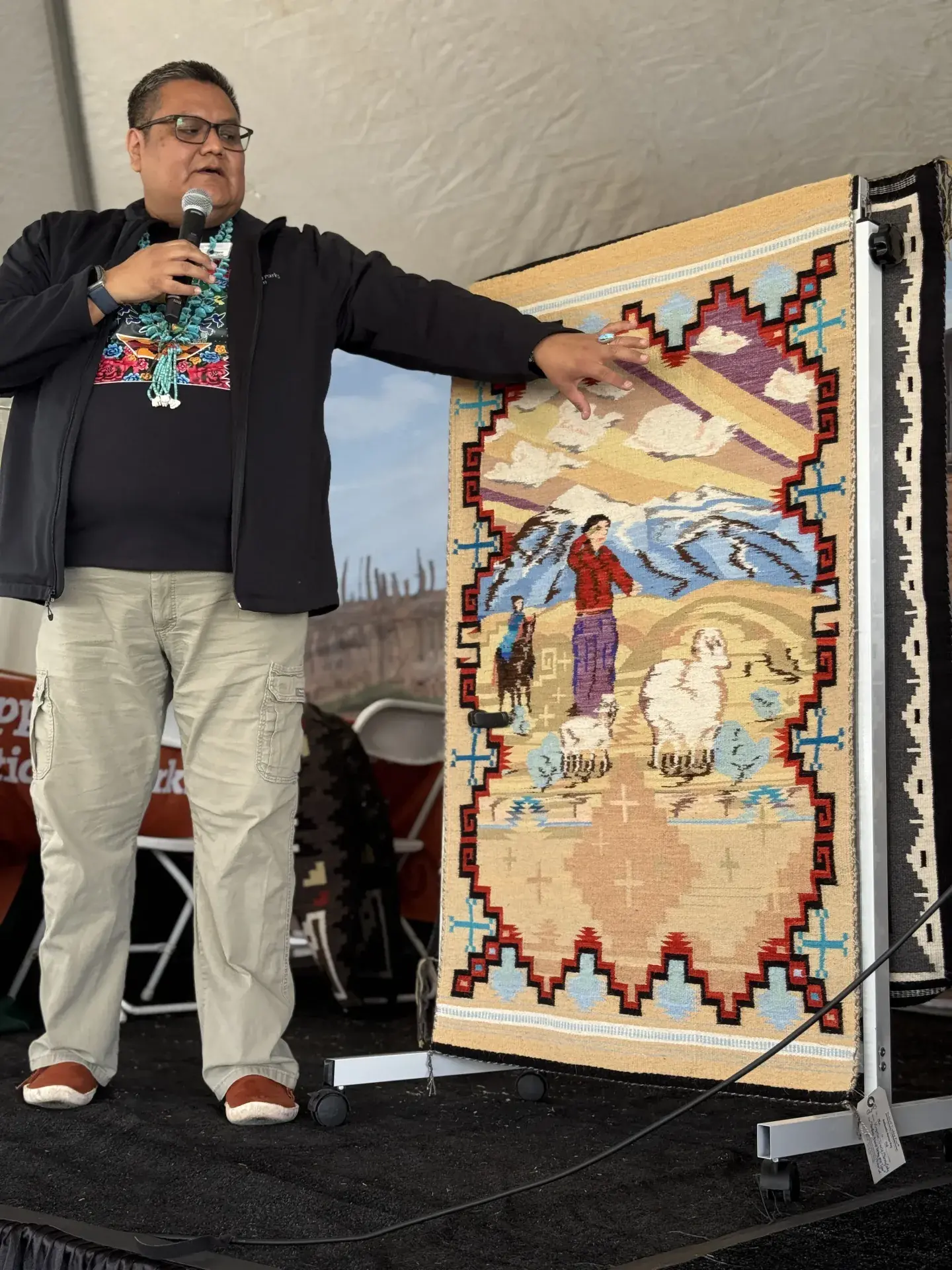
Bridging tradition and modernity
While traditional methods remain at the heart of Navajo weaving, contemporary artists have embraced new styles and materials. Wallace observes that younger weavers often incorporate commercial wool and synthetic dyes, allowing for a broader color palette and more intricate detailing. “There are a lot of new master weavers who are more into contemporary styles,” he says. “They like the more commercial type of wool, whereas our traditional weavers use what they have from their own livestock and the plants around their homes.” Traditional weavers raise their livestock, shearing and preparing their wool, and dyeing it using the colors available to them in the natural world around them.
The evolving nature of Navajo weaving is evident in the diversity of rugs Wallace brings in at Hubbell’s. Some artists maintain classic techniques, while others experiment with modern pictorial or freestyle designs.
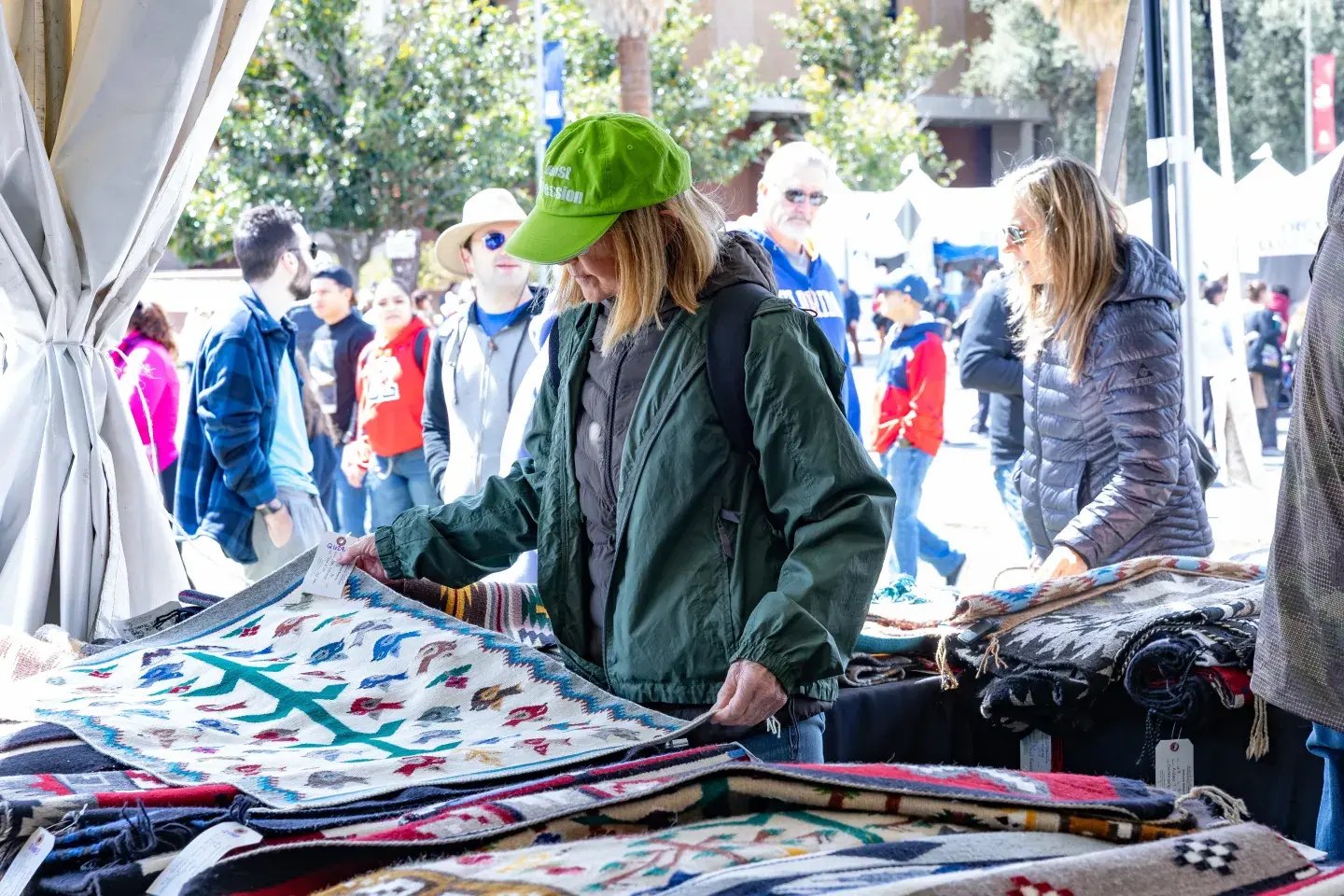
Wallace works closely with weavers, learning their stories and sharing them with buyers. “A lot of our buyers want to hear the story behind their rug,” he says. “They want to take that home with them, too.”
The weavers Wallace buys from are mostly from the Navajo Nation, but range across all three states that the nation encompasses. “The weaver from furthest away is from El Paso, though she used to live here in Ganado.” Each rug at Hubbell’s is one-of-a-kind and handmade from 100% raw materials, something that sets Hubbell’s apart from other trading posts.
Keeping the tradition alive: Hubbell on the Road
Wallace James Jr is more than a speaker and trader—he is a storyteller and historian, building a bridge between past and present. Wallace travels beyond the post to other locations to share his knowledge and help generate awareness of the invaluable history preserved at Hubbell Trading Post.
In his talks at what is familiarly known as “Hubbell on the Road,” Wallace takes visitors on a journey through the intricate process of Navajo weaving. He starts with the raw material—sheep’s wool—and walks audiences through every step: shearing, cleaning, carding, spinning, and dyeing. “A rug is 100% handmade, from sheep to rug,” he says. Wallace also explains the differences between traditional, home-spun wool and commercial wool, noting that each plays a role in contemporary weaving.
Through his talks, he ensures that the legacy of Navajo weaving remains strong, preserving the knowledge passed down through his family.
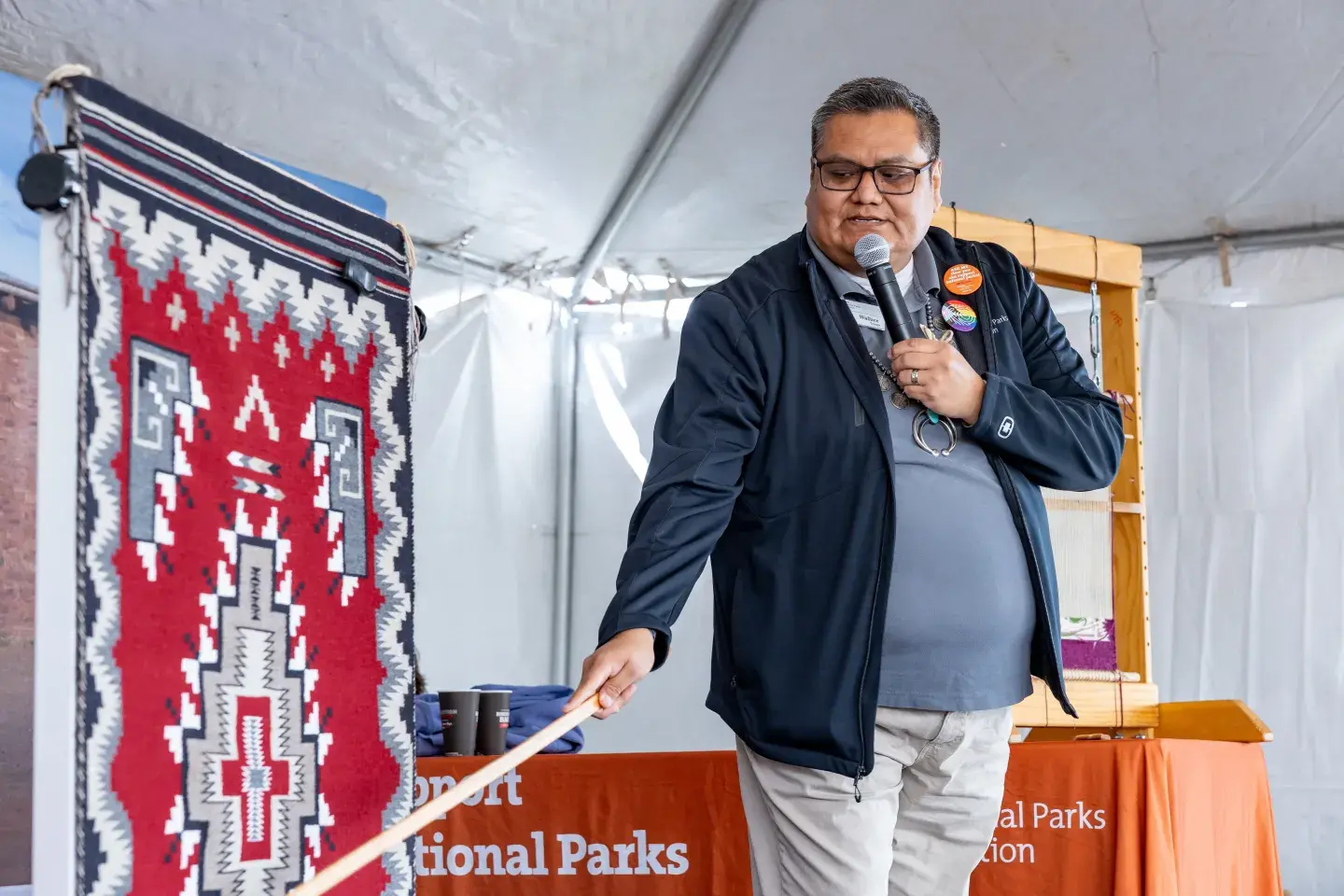
A winding path
Reflecting on his journey, Wallace acknowledges the path that brought him back to Hubbell’s. Though he pursued formal education outside the trading post, the legacy of his ancestors drew him home. “Silversmithing and the art that my family does paid for my education and got me where I am today,” he shares.
From the hogan his great-grandfather built to the trading post where his ancestors worked, Wallace’s journey is one of continuity, resilience, and a deep respect for the craft that is woven so tightly into his heritage. And through his work, the spirit of Navajo weaving at Hubbell Trading Post lives on.
For Wallace, every rug woven and every story shared continues a tradition that has endured for centuries. Whether speaking to visitors at Hubbell Trading Post or taking the legacy of Navajo weaving on the road, he honors the craftsmanship, history, and spirit of his people—one thread at a time.
You can connect with Wallace at Hubbell Trading Post National Historic Site, or at one of the Hubbell on the Road shows. Hubbell will be visiting White Sands National Park on May 17–18, 2025, and Petroglyph National Monument on July 19–20, 2025.
By Julie Thompson



